5 plaques located in the Square of Remembrance (Heroes’ Square), in Ramla, detailing Operation Danny, the operation in which Ramla was occupied. (Note also the name of the street where the square is located - Danny Mass Street, after which the operation is named)
In the next picture taken that day, 4 of the 5 plaques appear
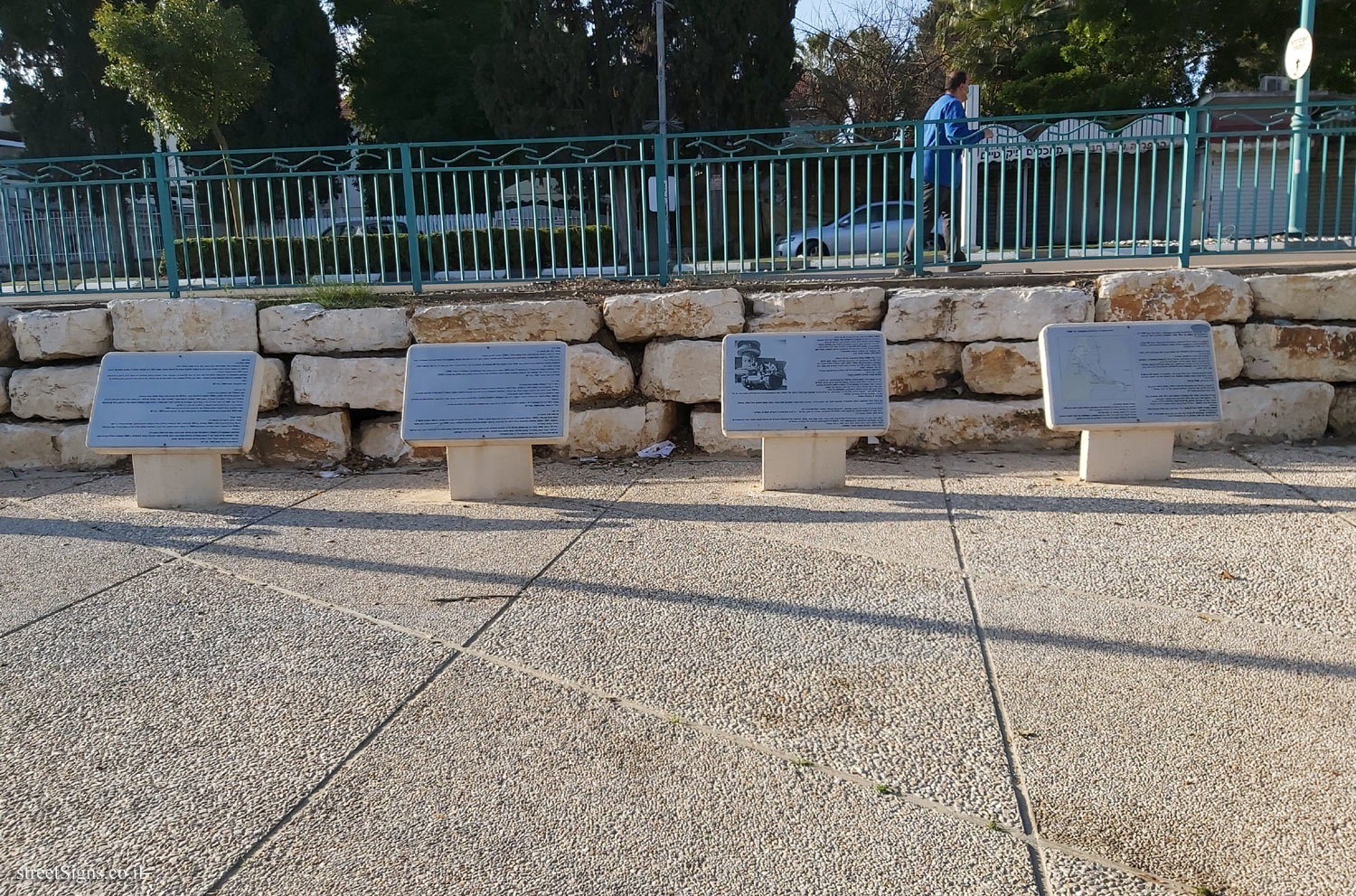 Click for a larger image
Click for a larger image And in a wider view of the square, one can also see the sculptures of the personalities associated with the operation, as well as the shadow of the statue "past present future".
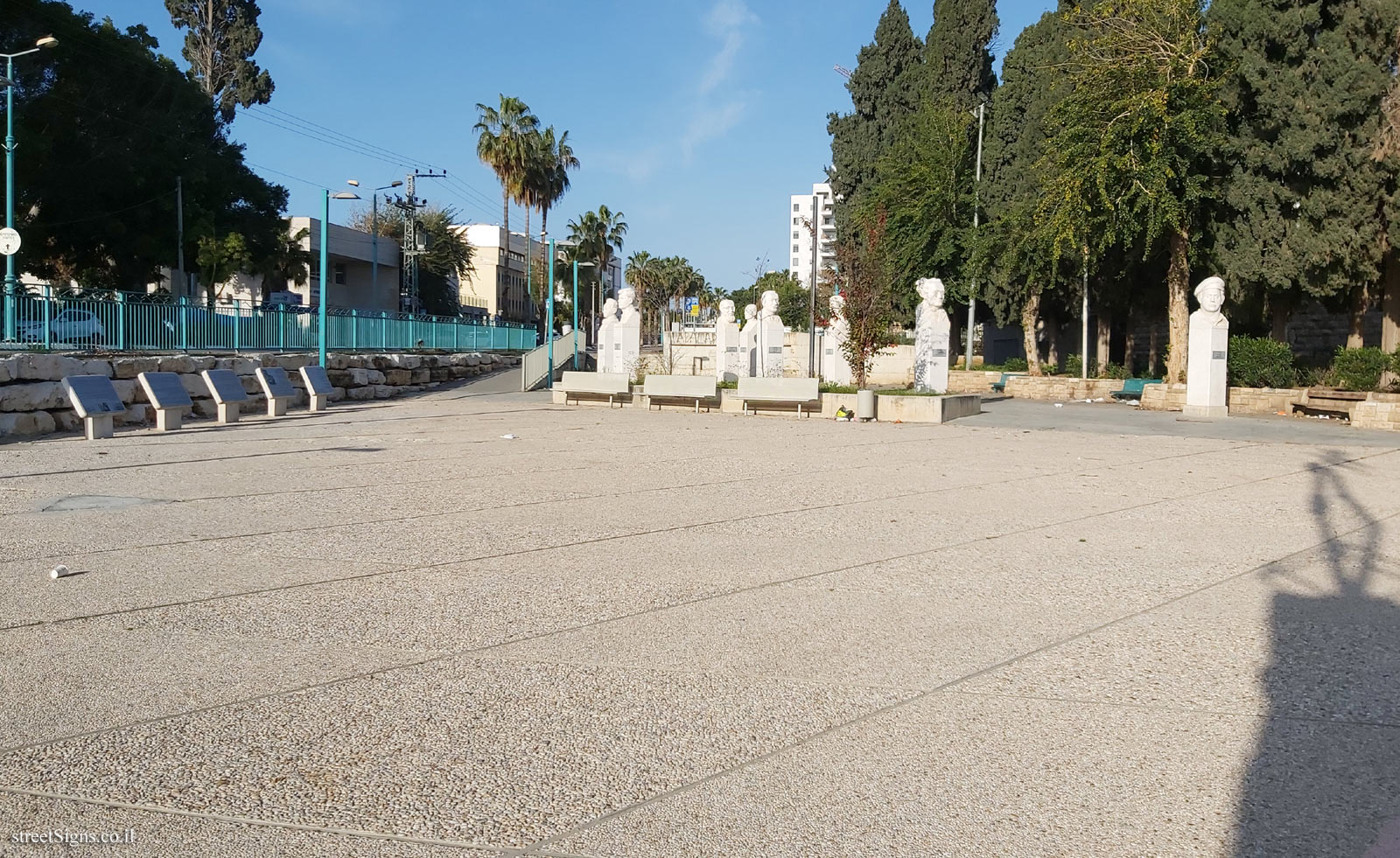 Click for a larger image
Click for a larger image The following pictures show the other plaques:
Plaque 2
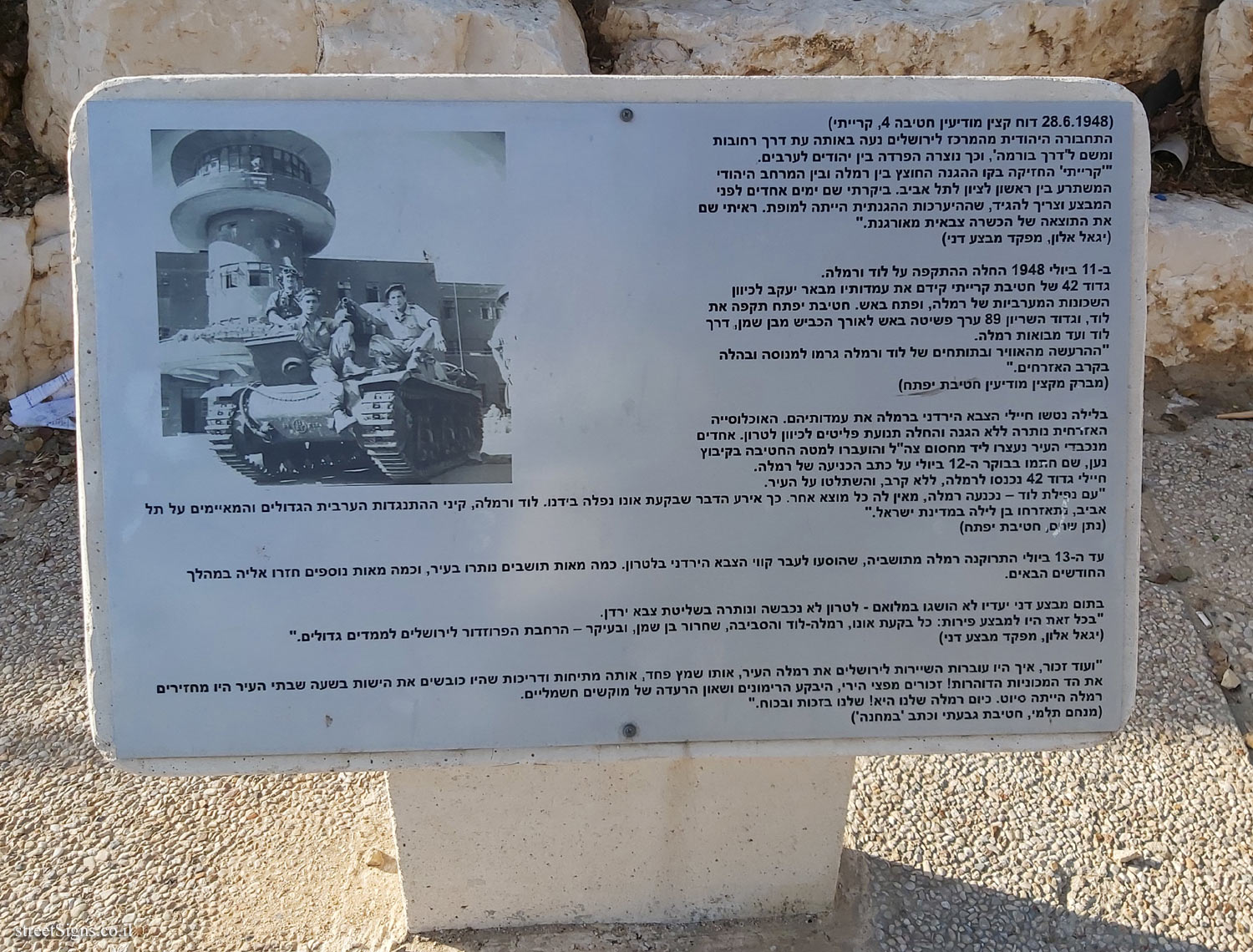 Click for a larger image
Click for a larger image Plaque 3
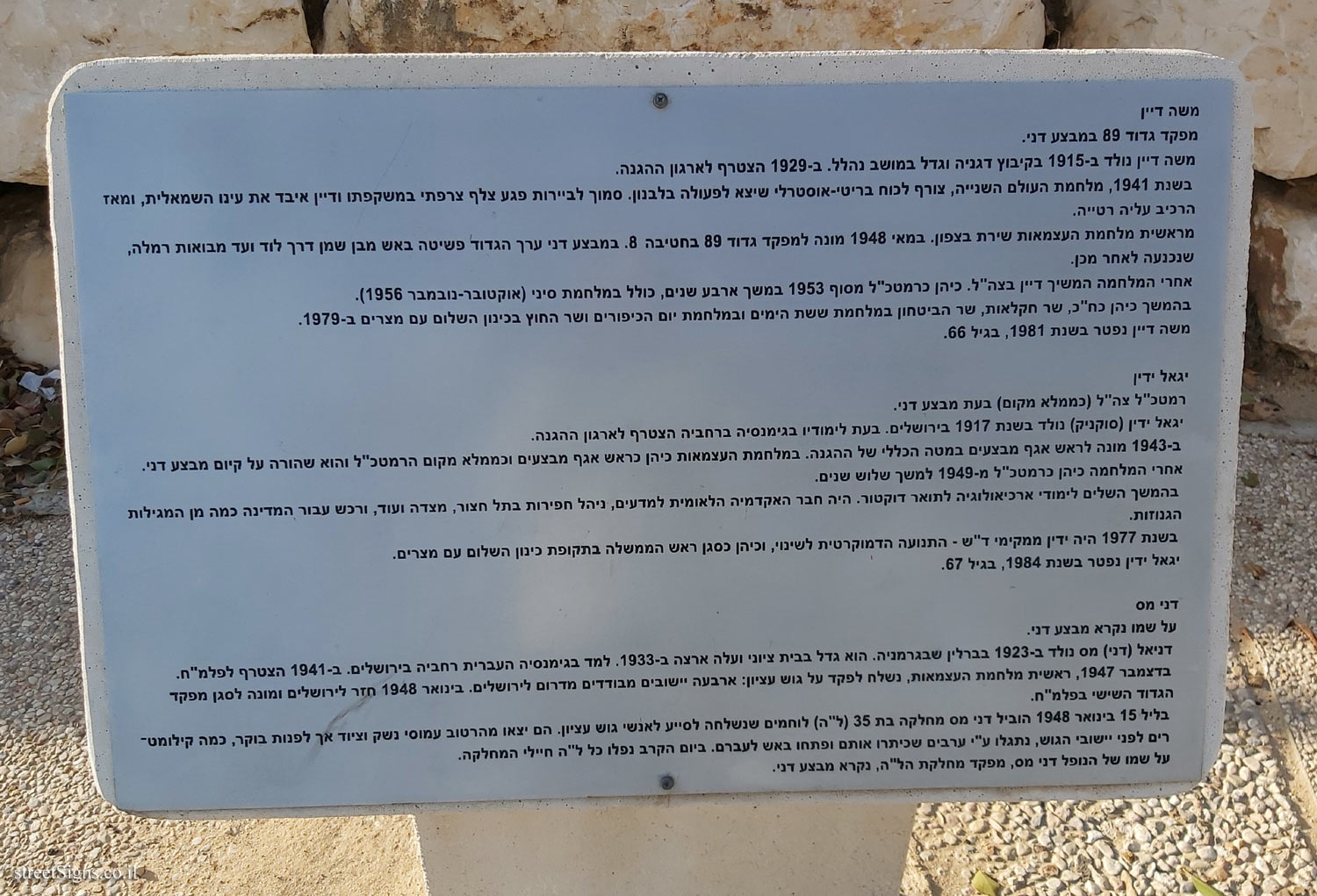 Click for a larger image
Click for a larger image Plaque 4
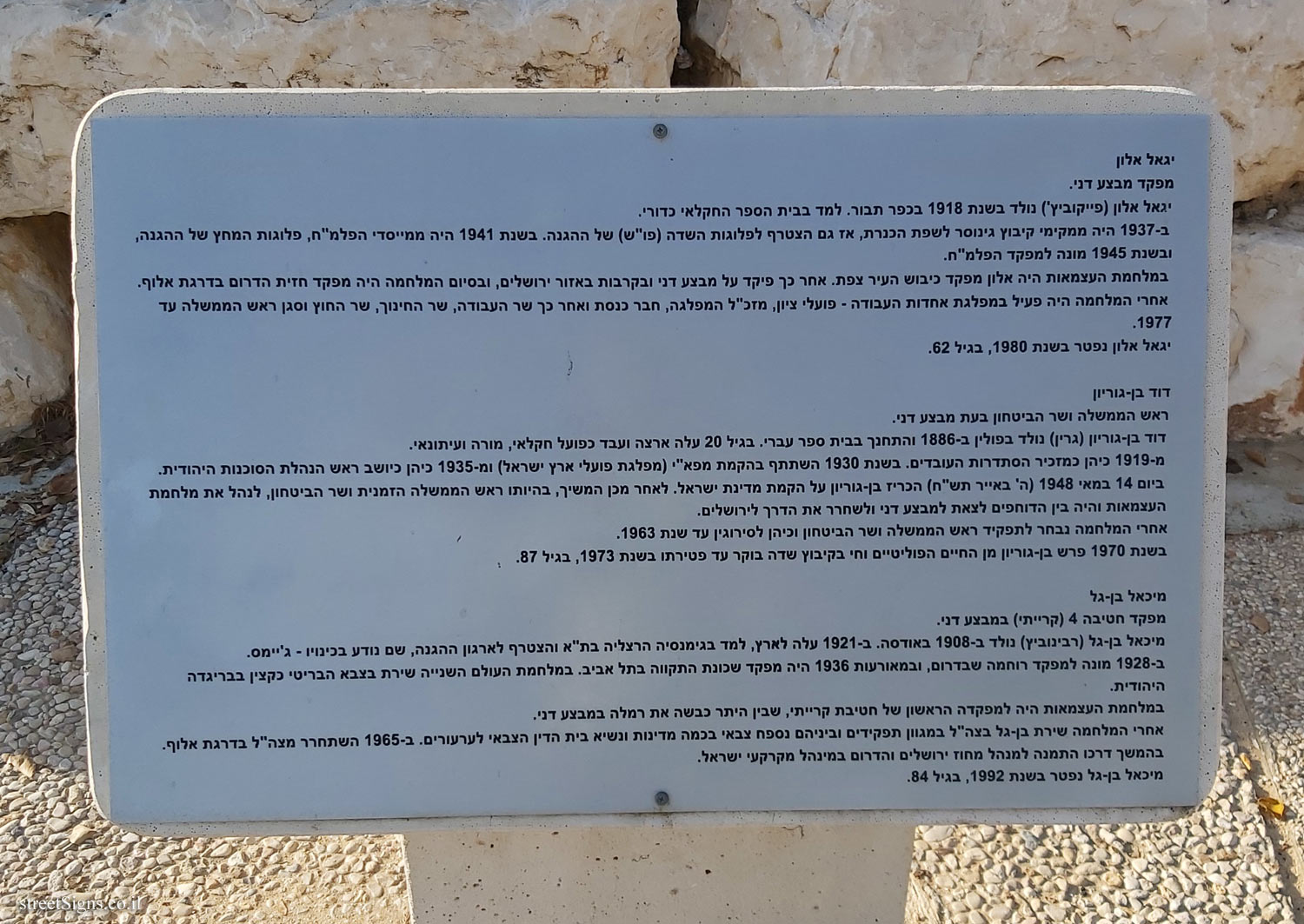 Click for a larger image
Click for a larger image Plaque 5
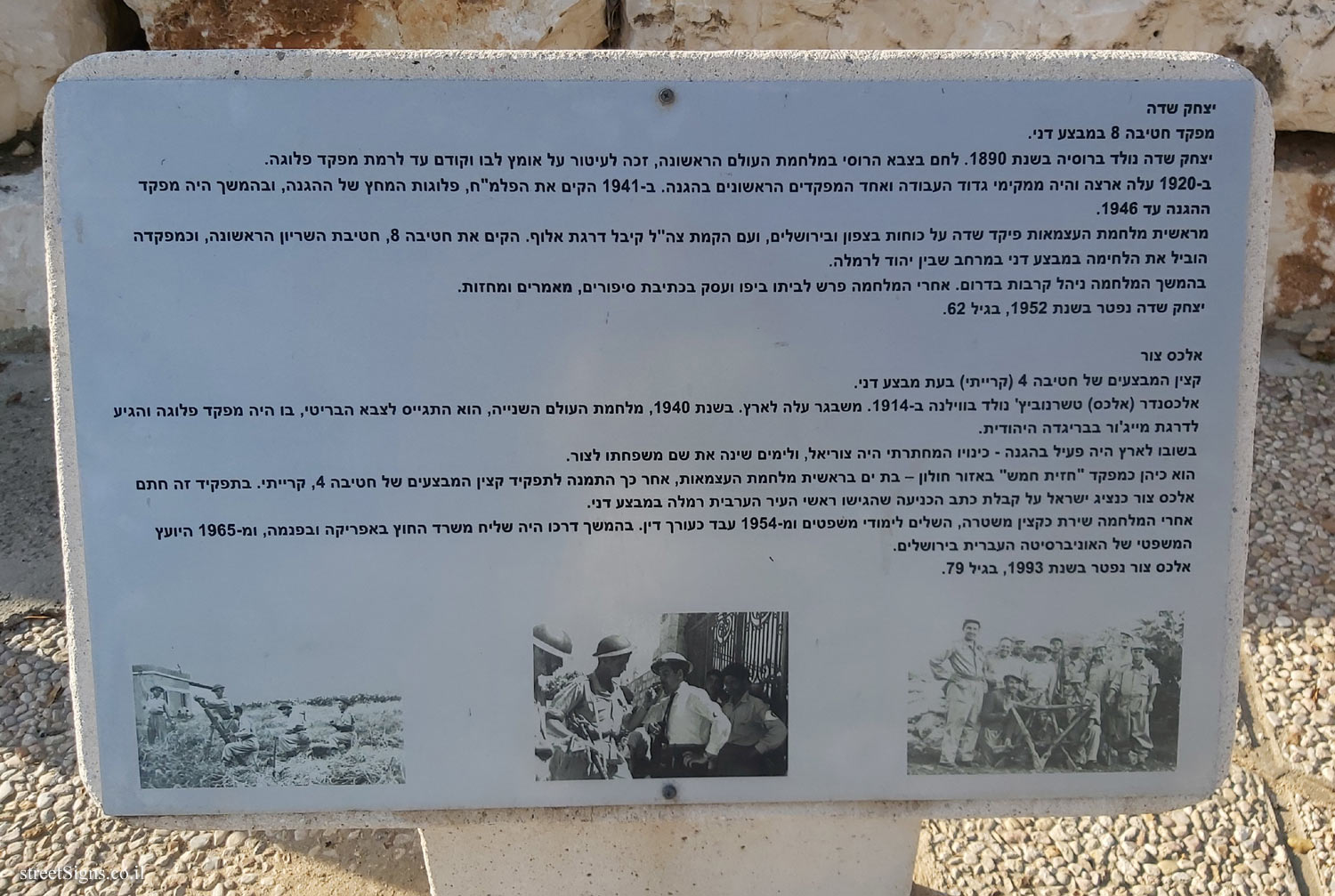 Click for a larger image
Click for a larger image Adjacent to the plaques are 8 statues of commanders and personnel associated with the operation
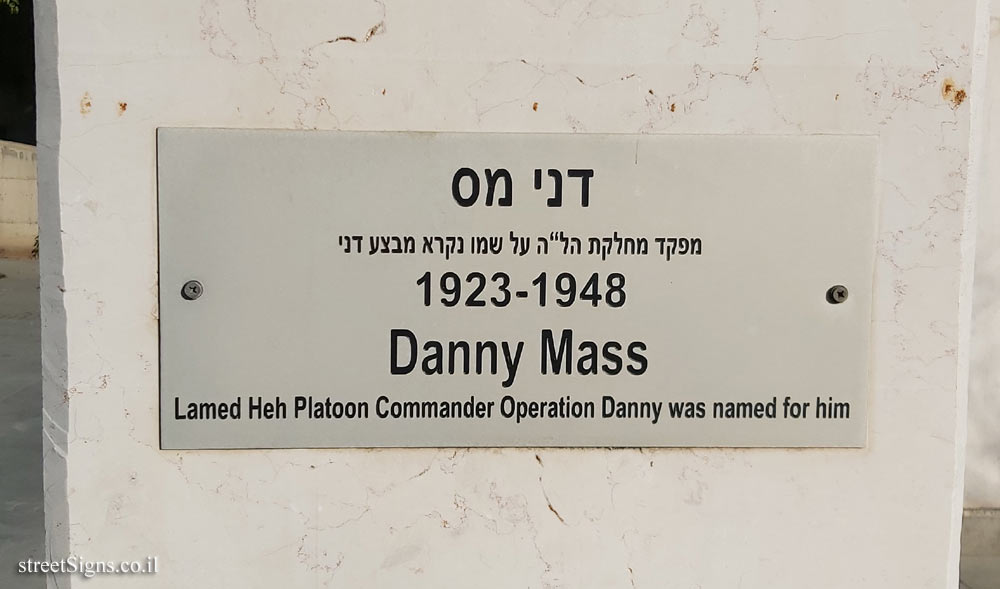 Click for sign's details Translation of the text on the sign
Click for sign's details Translation of the text on the sign:
One of the great operations of the War of Independence - began on July 9, 1948 and lasted until July 18, during the period known as the "Battles of the Ten Days".
In this operation, for the first time in its history, the IDF deployed a force the size of a division, about 9,000 fighters, and for the first time, an armored brigade was included in the force, which included armored vehicles and tanks.
The purpose of the operation was to take over the area between Rosh HaAyin and Lod, Ramla and Latrun, thus:
* Open the way to besieged Jerusalem;
* Expand the Israeli-controlled area on the way to Jerusalem (Jerusalem Corridor);
* Keep Jordanian army forces away from the entrances to Tel Aviv;
* Conquer the International Airport and the railway junction in Lod;
* Take control of the water supply pipeline to Jerusalem, which left the springs of Rosh HaAyin and passed through Latrun.
"We must occupy a wide corridor from Tel Aviv to Jerusalem, so that it is not just a path, but a settlement and economic area that connects Jerusalem with the rest of the Jewish state."
(David Ben-Gurion, June 24, 1948)
"The role: to eliminate the threat to Tel Aviv from Lod, Ramla and Rosh HaAyin, as well as to expand and stabilize the Jerusalem Corridor that was breached by the ’Burma Road’."
(Report of the General Staff Operations Division)
The Arab cities of Ramla and Lod at that time had about 18,000 inhabitants in each city, and in addition there were several thousand refugees from Jaffa and the surrounding villages.
In both cities, an armored company from the Jordanian army was held, with the help of volunteers and locals. In the IDF, the Jordanian military force was considered much larger.
The area east of the two cities was guarded by the Arabs, and they also controlled parts of the road to Jerusalem.
"The civilian population has not left the cities, and they do not believe that we will be able to conquer the two cities, because they are well fortified."
Map of a Operation Danny in the War of Independence, July 1948
[Battle Map]
The main operational moves
The 8th Armored Brigade and the 3rd Brigade (Alexandroni) occupied the villages between Rosh HaAyin and Lod;
The 11th Brigade (Yiftach) occupied the villages east of Lod;
The 11th Brigade (Yiftach) and the 8th Brigade captured Lod;
The 4th Brigade (Kiryati) pressed Ramla from the south and west, and took over the city after its surrender;
The 10th Brigade (Harel) occupied villages in the Jerusalem mountains, as far as the Beit Shemesh area.
[Plaque 2]
(June 28, 1948 Report of an Intelligence Officer, 4th Brigade, Kiryati )
Jewish transportation from the center to Jerusalem at that time moved through Rehovot and from there to the Burma Road, thus creating a separation between Jews and Arabs.
"’Kiryati’ had the defensive line between Ramla and the Jewish space between Rishon Lezion and Tel Aviv. I visited there a few days before the operation and it must be said that the defensive deployment was exemplary. I saw the result of organized military training there."
(Yigal Alon, Commander of Operation Danny)
On July 11, 1948, the attack on Lod and Ramla began.
The 42nd Battalion of the Kiryati Brigade advanced its positions from Beer Yaakov towards the western neighborhoods of Ramla, and opened fire. The Yiftach Brigade attacked Lod, and the 89th Armored Battalion carried out a fire raid along the road from Ben Shemen, through Lod to the entrances to Ramla.
"The shelling from the air and the cannons of Lod and Ramla caused a panic among the civilians."
(Telegram from the Yiftach Brigade Intelligence Officer)
At night, Jordanian army soldiers in Ramla abandoned their positions. The civilian population was left unprotected and a movement of refugees began in the direction of Latrun. Some of the city’s dignitaries were arrested near the IDF checkpoint and transferred to the brigade’s headquarters at Kibbutz Naan, where they signed Ramla’s letter of surrender on the morning of July 12.
The soldiers of the 42nd Battalion entered Ramla, without a fight, and took over the city.
"With the fall of Lod - Ramla surrendered, from which there is no other way out. This is how it happened that the Ono Valley fell into our hands. Lod and Ramla, the largest Arab resistance nests threatening Tel Aviv, were naturalized overnight in the State of Israel."
(Natan Shaham, Yiftach Brigade)
By July 13, Ramla had been emptied of its residents, who had been transported to the Jordanian army lines in Latrun. Several hundred residents remained in the city, and several hundred more returned to it over the next few months.
At the end of Danny Operation, its goals were not fully achieved - Latrun was not captured and remained under the control of the Jordanian army.
"Nevertheless, Operation had fruit: the entire Ono Valley, Ramla-Lod and the surrounding area, the liberation of Ben Shemen, and most importantly - the expansion of the corridor to Jerusalem to large dimensions."
"And remember, how the caravans would pass through Jerusalem, the city of Ramla, the same hint of fear, the same tension and alertness that would occupy the entity while the city houses would return the echo of the speeding cars!
Ramla was a nightmare. Today our Ramla is! Ours by right and by force. "
(Menachem Talmi, Givati Brigade and reporter of the ’Bamahane’)
[Picture of the 8th Brigade Hotchkiss tank and behind it the control tower of Lod Airport]
[Plaque 3]
Moshe Dayan
Commander of the 89th Battalion in a Danny Operation.
Moshe Dayan was born in 1915 in Kibbutz Degania and grew up in Moshav Nahalal. In 1929 he joined the Haganah.
In 1941, World War II, he joined a British-Australian force that went into action in Lebanon. Near Beirut, a French sniper hit his binoculars and Dayan lost his left eye, and has since been wearing an eyepatch.
From the beginning of the War of Independence he served in the north. In May 1948, he was appointed commander of the 89th Battalion in the 8th Brigade. In Operation Danny, the battalion carried out a raid from Ben Shemen through Lod to the entrances to Ramla, which subsequently surrendered.
After the war, Dayan continued in the IDF. He served as chief of staff from the end of 1953 for four years, including during the Sinai War (October-November 1956).
He later served as MK, Minister of Agriculture, Minister of Defense in the Six Day War and the Yom Kippur War and Foreign Minister in the establishment of peace with Egypt in 1979.
Moshe Dayan died in 1981, at the age of 66.
Yigal Yadin
IDF Chief of Staff (as deputy) during Danny Operation.
Yigal Yadin (Sukenik) was born in 1917 in Jerusalem. While studying at the Rehavia Gymnasium, he joined the Haganah organization.
In 1943, he was appointed head of the Operations Division at the General Staff of the Haganah. During the War of Independence, he served as head of the Operations Division and as deputy chief of staff, and he ordered the operation of the Danny Operation.
After the war he served as chief of staff from 1949 for three years.
He later completed his studies in archeology for a doctorate. He was a member of the National Academy of Sciences, conducted excavations in Tel Hatzor, Masada and more, and purchased some of the hidden scrolls for the state.
In 1977, Yadin was one of the founders of Dash - the Democratic Movement for Change, and served as Deputy Prime Minister during the establishment of peace with Egypt.
Yigal Yadin died in 1984, at the age of 67.
Danny Mass
Danny Operation is named after him.
Daniel (Danny) Mass was born in 1923 in Berlin, Germany. He grew up in a Zionist home and immigrated to Israel in 1933. He studied at the Rehavia Hebrew Gymnasium in Jerusalem. In 1941 he joined the Palmach.
In December 1947, at the beginning of the War of Independence, he was sent to command Gush Etzion: four isolated settlements south of Jerusalem. In January 1948, he returned to Jerusalem and was appointed deputy commander of the Sixth Battalion in the Palmach.
On the night of January 15, 1948, Danny Mass led a platoon of 35 fighters who were sent to help the people of Gush Etzion. On the day of the battle all the soldiers of the platoon fell.
Danny Operation was named after the fallen Danny Mass, commander of the 35 platoon.
[Plaque 4]
Yigal Allon
Commander of Danny Operation.
Yigal Alon (Peikovich) was born in 1918 in the village of Tavor. Studied at the Kadoorie Agricultural School.
In 1937 he was one of the founders of Kibbutz Ginosar on the shores of the Sea of Galilee, then he also joined the field companies (PUSH) of the Haganah. In 1941 he was one of the founders of the Palmach, the strike companies of the Haganah, and in 1945 he was appointed commander of the Palmach.
During the War of Independence, Alon was the commander of the occupation of the city of Safed. He later commanded Operation Danny and the battles in the Jerusalem area, and at the end of the war was the commander of the southern front with the rank of general.
After the war, he was active in the Ahdut HaAvodah party - Poalei Zion, the party’s secretary general, Member of Knesset and later Minister of Labor, Minister of Education, Minister of Foreign Affairs and Deputy Prime Minister until 1977.
Yigal Alon died in 1980, at the age of 62.
David Ben Gurion
The Prime Minister and the Minister of Defense during Operation Danny.
David Ben-Gurion (Green) was born in Poland in 1886 and was educated in a Hebrew school. At the age of 20 he immigrated to Israel and worked as a farmer, teacher and journalist.
From 1919 he served as secretary of the Histadrut. In 1930 he participated in the establishment of Mapai (the Workers’ Party of the Land of Israel) and from 1935 he served as chairman of the Jewish Agency.
On May 14, 1948, Ben-Gurion declared the establishment of the State of Israel. After that, he continued, as the interim prime minister and defense minister, to wage the War of Independence and was among those pushing for Danny Operation and liberating the road to Jerusalem.
After the war he was elected Prime Minister and Minister of Defense and served intermittently until 1963.
In 1970, Ben-Gurion retired from political life and lived in Kibbutz Sde Boker until his death in 1973, at the age of 87.
Michael Ben-Gal
Commander of the 4th Brigade (Kiryati) in Operation Danny.
Michael Ben-Gal (Rabinowitz) was born in 1908 in Odessa. In 1921 he immigrated to Israel, studied at the Herzliya Gymnasium in Tel Aviv and joined the Haganah organization, where he became known as James.
In 1928 he was appointed commander of Ruhama in the south, and during the events of 1936 he was commander of the Hatikva neighborhood in Tel Aviv. During World War II he served in the British Army as an officer in the Jewish Brigade.
During the War of Independence, he became the first commander of the Kiryati Brigade, which, among other things, conquered Ramla in Operation Danny.
After the war, Ben-Gal served in the IDF in a variety of positions, including a military attaché in several countries and president of the Military Court of Appeals. In 1965, he was discharged from the IDF with the rank of major general.
Later in his career, he was appointed director of the Jerusalem and Southern District of the Israel Land Administration.
Michael Ben-Gal died in 1992, at the age of 84.
[Plaque 5]
Yitzhak Sadeh
Commander of the 8th Brigade in Operation Danny.
Yitzhak Sadeh was born in Russia in 1890. He fought in the Russian army during the First World War, received a medal for his courage and was promoted to the rank of company commander.
In 1920 he immigrated to Israel and was one of the founders of the Labor Battalion and one of the first commanders in the Haganah. In 1941, he established the Palmach, the Haganah’s strike companies, and later served as commander of the Haganah until 1946.
From the beginning of the War of Independence, Sadeh commanded forces in the north and in Jerusalem, and with the establishment of the IDF, he received the rank of major general.
Later in the war he fought battles in the south. After the war, he retired to his home in Jaffa and wrote stories, essays and plays.
Yitzhak Sadeh died in 1952, at the age of 62.
Alex Zur
Operations Officer of the 4th Brigade (Kiryati) during Operation Danny.
Alexander (Alex) Tchernovitz was born in Vilnius (Vilna) in 1914. When he grew up he immigrated to Israel. In 1940, World War II, he enlisted in the British Army, where he was a company commander and reached the rank of Major in the Jewish Brigade.
On his return to Israel, he was active in the Haganah - his underground nickname was Tzuriel, and later changed his last name to Tzur.
He served as commander of the "Front Five" in the Holon-Bat Yam area at the beginning of the War of Independence, then was appointed operations officer of the 4th Brigade, Kiryati. In this position, Alex Tzur, as Israel’s representative, signed the acceptance letter of submission submitted by the mayors of the Arab city of Ramla in Operation Danny.
After the war he served as a police officer, completed law studies and from 1954 worked as a lawyer. Later in his career he was an emissary of the Ministry of Foreign Affairs in Africa and Panama, and from 1965 the Legal Adviser of the Hebrew University of Jerusalem.
Alex Zur died in 1993, at the age of 79.
[Pictures from the time of the battles]
Learn about:

 Click for a larger image
Click for a larger image  Click for a larger image
Click for a larger image  Click for a larger image
Click for a larger image  Click for a larger image
Click for a larger image  Click for a larger image
Click for a larger image  Click for a larger image
Click for a larger image  Click for sign's details
Click for sign's details